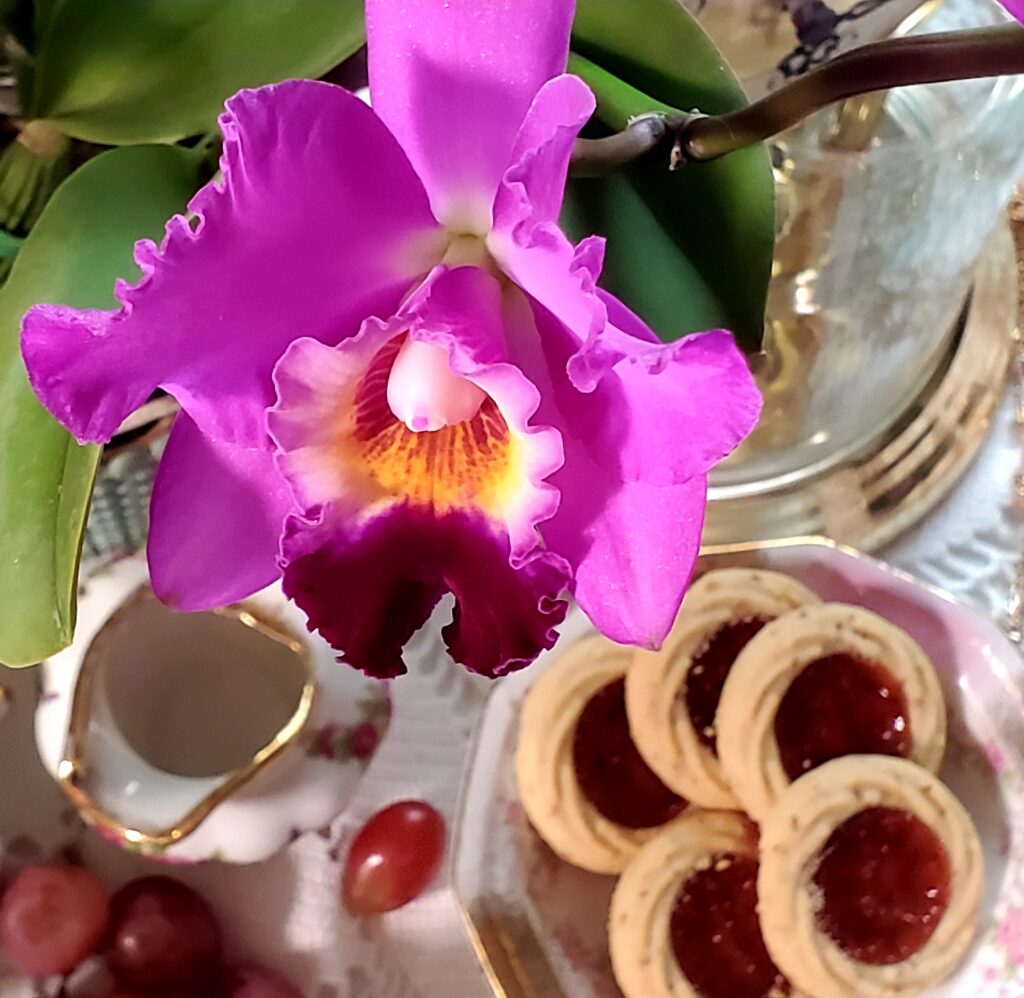Some Examples of Fragrant Orchids
Orchids, with their delicate beauty, captivate not only with their appearance but also with their enchanting fragrances. But what if you’re orchid just isn’t cooperating? No matter how much you try, the orchid isn’t living up to its name. Before you make an appointment with the otolaryngologist, there may be some practical reasons that your orchid isn’t functioning properly.
Orchids can lose their scent due to (1) environmental changes, like temperature, humidity, and light; (2) stress from overwatering, underwatering, or sudden environmental shifts; (3) aging, (4) Nutritional deficiencies; and (5) pests or diseases.

Before I dive into those items one by one and list the problems of non-scented orchids or why they should have fragrance, let me introduce you to some exquisite examples of fragrant orchids that will hopefully transport you to a world of sensory delight (starting off with a positive note).
First, we have the intoxicating scent of the Cattleya orchid, reminiscent of a blend of citrus and floral notes, evoking a sense of freshness and elegance. I had a Cattleya right next to my computer in my home office, and when I first walked in to work in the mornings, it took me a second to be able to breathe. I eventually had to open a window, but the scent was gone by midday. I quickly learned to keep the home office door open during the night–it’s that powerful in a closed room.
Next, the sweet and spicy aroma of the Oncidium orchid, with hints of vanilla and cinnamon, creates a warm and inviting atmosphere. The most famous Oncidium for Fragrance is the Sherry Baby with hints of chocolate. The Maxillaria tenuifolia has a coconut smell, reminding me of a Pina Colada.
Most growers will have a Phalaenopsis orchid, known for its soft, floral fragrance with a touch of jasmine, offering a calming and soothing experience. If you’re unsure what kind of orchid you have, it’s probably a Phalaenopsis orchid.
Lastly, the Vanda orchid delights with a fruity and floral fragrance, akin to a bouquet of fresh blooms on a sunny day. Each of these fragrant orchids has its unique charm, adding a touch of nature’s beauty to your surroundings.
But what happens when these scents just aren’t there when you know they should be? In this article, I will focus on some possible reasons that this is happening, and how to fix that.
Environmental Factors:
Changes in environmental factors such as temperature, light, and humidity significantly determine the fragrance production of orchids. Orchids require specific environmental conditions to release their characteristic scents effectively. If these conditions are not met, the orchid may fail to emit its expected fragrance, leaving growers puzzled and disappointed.
After all, I spent all that money on a fragrant orchid; at least it could do its job, right? Maintaining a careful balance of these environmental factors is essential to ensure that orchids bloom with their full aromatic potential, enhancing the overall sensory experience for enthusiasts and admirers alike.
Temperature
Temperature plays a crucial role in determining the intensity of fragrance in orchids. Different orchid species have specific temperature requirements for optimal growth and flowering, and these conditions can influence fragrance production.
Warm Temperatures: 64º to 90º F (18º to 32º C.)
Many orchid species, particularly tropical ones, thrive in warmer temperatures. Warmer temperatures often stimulate metabolic processes within the plant, including fragrance production. In such conditions, orchids may release their fragrances more readily, resulting in a stronger and more pronounced scent.
Cool Temperatures: 50ºF (10ºC) during winter and 75ºF (24ºF)
Some orchid species, particularly those from cooler climates or higher elevations, prefer cooler temperatures. While cooler temperatures may slow down metabolic processes in the plant, they can also enhance the longevity and intensity of the fragrance. Orchids exposed to cooler temperatures may produce fragrances that are more concentrated and long-lasting.
Temperature Fluctuations:
Rapid fluctuations in temperature can stress orchids and affect their fragrance production. Extreme temperature variations, such as sudden drops or spikes, may disrupt metabolic processes and lead to reduced fragrance intensity or even loss of scent.
This happens a lot during small events, like buying an orchid in a warm supermarket during winter, driving it home in the cold car, leaving the window open during winter, or having your orchid by the sink and draining a boiling pan of pasta in the sink as the hot air rises…
Intermediate Temperature Range: 55º to 86ºF (13º to 30º C).
Each orchid species has its own preferred temperature range for fragrance production. If you aren’t sure of what range to keep your orchid, then it’s probably an intermediate orchid. Maintaining temperatures within this optimal range, typically between intermediate levels and warm-growing levels, around 60°F to 80°F (15°C to 27°C) for many orchids, can help ensure consistent and vibrant fragrance expression.
You can download a free guide (it’s one page) about orchid temperatures here
Overall, temperature management is crucial for maximizing fragrance intensity in orchids. Providing the appropriate temperature conditions based on the species’ preferences can help orchids produce their characteristic scents at their best.
Light
Changes in light conditions play a significant role in influencing the fragrance of orchids. Generally, orchids exposed to higher light levels tend to produce stronger fragrances. This is because increased light intensity stimulates photosynthesis and metabolic activity within the plant, contributing to enhanced fragrance production.
On the other hand, orchids that do not receive adequate light may prioritize energy allocation towards other processes, potentially leading to weaker or diminished fragrance expression.
Providing the right amount of light tailored to the specific requirements of the orchid species is crucial for maintaining or enhancing fragrance levels. Understanding the concept of Foot Candles can be helpful in determining the appropriate light conditions for orchids. Foot Candles measure the amount of light reaching a specific area, essential for assessing the light intensity received by orchids.
I wrote an article about how foot candles can affect blooms, which you can read her e, and also another article about specific lighting
e, and also another article about specific lighting .
.
Humidity
Changes in humidity can also affect the intensity of the fragrance of an orchid. Orchids generally thrive in environments with moderate to high humidity levels, as this helps to maintain their overall health and supports proper physiological processes, including fragrance production.
When humidity levels are too low, orchids may experience stress as they lose moisture more rapidly through transpiration. This can lead to dehydration and reduced metabolic activity, potentially impacting fragrance production. In such conditions, orchids may produce weaker or less intense fragrances.
Conversely, when humidity levels are too high, orchids may be at risk of developing fungal or bacterial infections, which can compromise their health and inhibit fragrance production. However, within the optimal range of humidity, typically around 50-70% for most orchids, the plant can thrive and allocate resources towards fragrance production, resulting in a more pronounced and pleasant scent.
Stress:
Orchids are sensitive plants that can easily become stressed by various factors, including overwatering, underwatering, or sudden environmental changes. When orchids experience stress, their primary focus shifts towards survival mechanisms, diverting energy from producing a smell. This redirection of resources can decrease the intensity or quality of the orchid’s scent.
Overwatering can lead to root rot and deprive the plant of essential oxygen, causing stress and hindering fragrance production. On the other hand, underwatering can lead to dehydration and nutrient deficiencies, further exacerbating the plant’s stress response.
To mitigate stress and promote optimal fragrance production, it is crucial to maintain stable environmental conditions (don’t move your orchid from spot to spot, don’t repot it every 3 months, nor turn its vase every week) and provide proper watering practices, and avoid sudden fluctuations that can disrupt the orchid’s equilibrium.
Age of the Flowers:
As the orchid blossoms age, they may gradually lose their fragrance. This is a natural process, and the intensity of the scent may diminish over time.
To address the issue of diminishing fragrance in aging orchid blossoms, consider pruning fading flowers to redirect the plant’s energy toward developing new, fragrant blooms. Regular deadheading promotes continuous flowering and maintains a “somewhat” consistent fragrance experience in your orchid collection. But even with deadheading, it doesn’t make that much difference. Sorry…
Nutritional Deficiencies:
Orchids require specific nutrients for healthy growth and flowering. If the plant is not receiving adequate nutrition, it may not produce fragrant blossoms.
To address nutritional deficiencies and promote healthy fragrance production in orchids, it’s essential to choose a fertilizer that provides the necessary nutrients in appropriate proportions. When focusing on enhancing blossom fragrance, you’ll want to prioritize fertilizers that are tailored to support flowering and overall plant health. Here’s what you should look for:
Balanced Orchid Fertilizer: You don’t need to look for a balanced orchid fertilizer formulated specifically for orchids. Those are overrated. Nutrition is nutrition in any plant. The only difference is that orchids will need less, so diluting is the answer.
Any fertilizer typically has an N-P-K (Nitrogen-Phosphorus-Potassium) ratio designed to support both vegetative growth and flowering. A balanced fertilizer, such as one with an N-P-K ratio of 20-20-20 or 20-10-20, provides essential nutrients for overall plant health and encourages robust flower development. You should be using this one regularly.
Increased Phosphorus (P) Content: Phosphorus is crucial for promoting flowering in plants. Therefore, selecting a fertilizer with a higher phosphorus content (the second number in the NPK ratio) can help stimulate blossom production and enhance fragrance.
Look for fertilizers labeled as “bloom boosters” or those with a higher middle number in the N-P-K ratio, such as 10-30-20. These formulations are specifically designed to promote flowering and can be beneficial for orchids that need a fragrance boost.
Micronutrients: In addition to the primary macronutrients (nitrogen, phosphorus, and potassium), orchids require various micronutrients for healthy growth and flowering. These micronutrients include calcium, magnesium, iron, zinc, manganese, and others. Choose a fertilizer that contains a broad spectrum of micronutrients to ensure that your orchids have access to all the essential elements they need for optimal fragrance production.
Slow-Release Formulations: Consider using slow-release fertilizers for orchids, which provide a steady supply of nutrients over an extended period. This can help prevent over-fertilization and minimize the risk of nutrient imbalances, ensuring that your orchids receive a consistent and balanced nutrient supply to support fragrance production without causing stress or nutrient deficiencies.
When fertilizing orchids, always follow the manufacturer’s instructions regarding application rates and frequency. Additionally, it’s essential to monitor your orchids closely and adjust fertilization practices based on their individual needs and responses. With proper fertilization, you can help ensure that your orchids receive the nutrients they need to produce vibrant, fragrant blossoms.
Pests or Diseases:
Pests or diseases can significantly impact the health and fragrance production of orchids. Pest infestations, including aphids and spider mites, can weaken the plant by feeding on its tissues and disrupting its growth. These pests not only damage the orchid physically but also stress it, leading to a decline in fragrance production. On the other hand, fungal and bacterial infections can directly affect the orchid’s overall health and scent output, further diminishing its aromatic qualities.
To combat these challenges and revive the orchid’s fragrance, proactive measures are essential.
Regularly inspect your orchids for any signs of pest infestations or disease symptoms. Implementing preventive measures, such as maintaining proper air circulation and humidity levels, can help deter pests and reduce the risk of infections.
If pests or diseases are detected, prompt treatment with appropriate remedies or pesticides is crucial to protect the orchid and prevent further damage. I have written specific articles about spider mites, aphids, mealy bugs, and all the other unknown critters that could be infesting your potting media. To find out what it might be, you can start with this article: Orchid Bark Bugs: 5 Creatures that Infest Potting Mix
By promptly addressing pest and disease issues and providing the necessary care, you can support your orchid’s recovery and help it regain its natural fragrance over time. Regular monitoring and proactive management are key to maintaining a healthy and fragrant orchid.
Don’t Stop Learning!
If you want to be included in more information and get a 14-page fertilization guide, please sign up for my newsletter. I don’t spam, but send emails out bi-monthly with some curious topics of interest. If you want more information, click here to go to a specific page on this website where I explain it more in detail.

Also, if you are looking for an orchid journal to keep your notes specifically about orchid care, check out my 2 solutions for that on this page. If note-keeping isn’t your thing, then there is a free excel spreadsheet that you can download. Click here for more information on how to do that.
If you subscribe to my newsletter, I will send you a 14-page guide on the main tips of orchid fertilizer. It is downloadable and you can print it out on your computer. I designed the guide to double up as a coloring book, just to make it fun.
Conclusion
Thank you for exploring the factors that can impact the fragrance of orchids. If you want to read more, I wrote about the 18 most fragrant orchids in this article , and I tried my best to describe their smell.
, and I tried my best to describe their smell.
Understanding the importance of environmental factors, stress, age of the flowers, nutritional deficiencies, and pests or diseases is crucial in maintaining the aromatic qualities of your orchids. By addressing these factors effectively, you can enhance the fragrance production of your orchids and ensure their overall health and vitality.
With dedication and care, you can enjoy a beautiful aromatic orchid collection that brings joy and beauty to your space. Happy Cultivating!


A pretty thorough presentation of information.
Impressive as always!